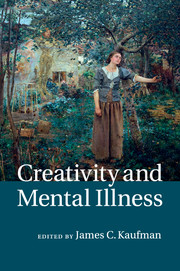Book contents
- Frontmatter
- Dedication
- Contents
- List of figures
- List of tables
- List of contributors
- Preface
- Acknowledgments
- Part I Creativity and mental illness: the state of the field
- Part II Cognitive and neuroscientific perspectives on creativity and mental illness
- Part III Creativity and the spectrum of mental illness
- Part IV Creativity and mental illness: possible commonalities
- 12 The shared vulnerability model of creativity and psychopathology
- 13 On the fragility of the artist: art’s precarious triad
- 14 Creativity as “compensatory advantage”: bipolar and schizophrenic liability, the inverted-U hypothesis, and practical implications
- Part V Creativity and mental health
- Part VI Creativity and mental illness: what now?
- Index
- References
14 - Creativity as “compensatory advantage”: bipolar and schizophrenic liability, the inverted-U hypothesis, and practical implications
from Part IV - Creativity and mental illness: possible commonalities
Published online by Cambridge University Press: 05 August 2014
- Frontmatter
- Dedication
- Contents
- List of figures
- List of tables
- List of contributors
- Preface
- Acknowledgments
- Part I Creativity and mental illness: the state of the field
- Part II Cognitive and neuroscientific perspectives on creativity and mental illness
- Part III Creativity and the spectrum of mental illness
- Part IV Creativity and mental illness: possible commonalities
- 12 The shared vulnerability model of creativity and psychopathology
- 13 On the fragility of the artist: art’s precarious triad
- 14 Creativity as “compensatory advantage”: bipolar and schizophrenic liability, the inverted-U hypothesis, and practical implications
- Part V Creativity and mental health
- Part VI Creativity and mental illness: what now?
- Index
- References
Summary
The idea that creativity is somehow associated with major mental illness is an ancient one that goes back at least as far as Aristotle, who wrote that all of the creative geniuses of his time were “inclined toward insanity” (see Becker, this volume). The notion that creative genius and “madness” are linked is still a popular one, stoked in part by the famous examples of eminent artists, such as van Gogh, and the Nobel-prizewinning mathematician and economist John Nash, who was hospitalized for schizophrenia and was the subject of the film, A Beautiful Mind.
While this “mad genius stereotype,” as Silvia and Kaufman (2010) put it, is widely held, the research we will review in this chapter suggests that the stereotype gives a misleading impression of the actual relations between creativity and psychopathology. This research suggests that psychotic symptoms actually tend to hinder creativity, and that it is the presence of other psychological characteristics associated with genetic liability or susceptibility to certain mental illnesses that actually aid creativity (Kinney and Richards, 2011).
- Type
- Chapter
- Information
- Creativity and Mental Illness , pp. 295 - 318Publisher: Cambridge University PressPrint publication year: 2014
References
- 8
- Cited by



